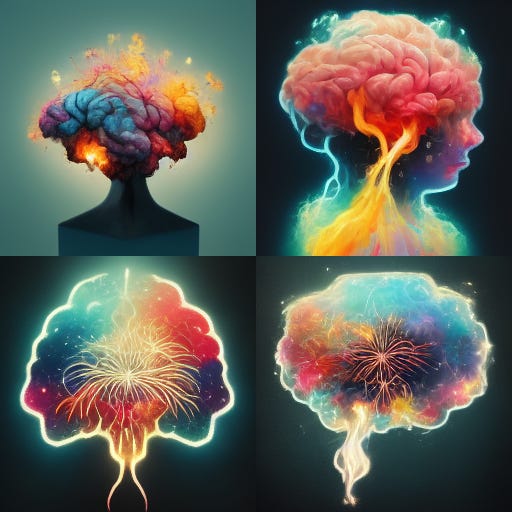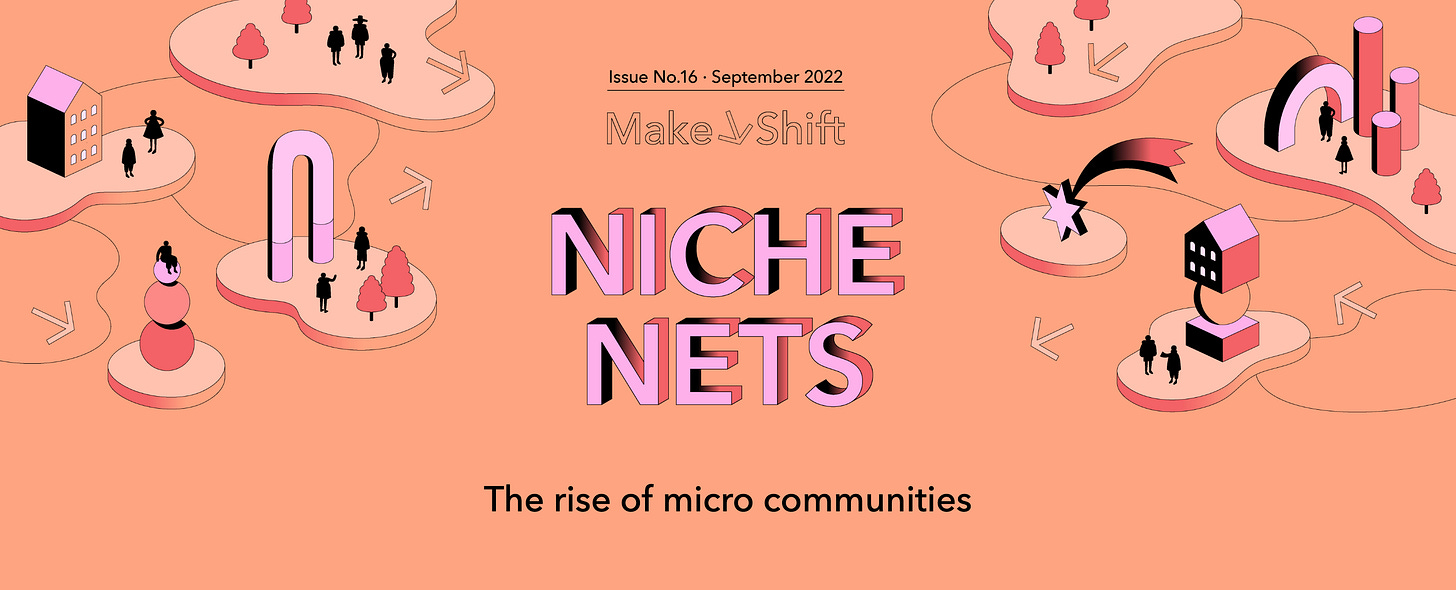🧋✨The Nexialist #0085
AI: Engines for the Imagination? | Methexis in Darkness | Philistinism | Meta-text Consumption | Status Struggles | The Fluid Self | Niche Nets | Bronfenbrenner's Bioecological Model
Welcome to your weekly session of digital neural stimulation, The Nexialist!
Hello, beautiful readers! I’m writing this Nexialist a bit light-headed after taking the monkeypox vaccine, so I’ll keep the intro shott. This week has been especially busy with work, but I still like to save some time to go through some articles, videos and memes, and try to bring something that makes your brain feel some cuddles (or pokes sometimes). I appreciate that you keep coming back and sharing. Thank you and enjoy!
1 year ago » ⚱️✨The Nexialist #0037 : Everybody Dies | Ask Your Parents | The New Rules of Gathering | See More Each Other | Time is Your Home | Love to Remember
🦾AI: Engines for the Imagination?
A lot of AI art has been coming my way in my feeds, on Twitter, Instagram, Reddit and in the news and I’m loving it. The one above by DreamComputr was quite impressive, with an AI-enhanced layer on top of live footage. A Journey Through a Boy’s Life by Buttah was also quite impressive (I could not embed it here).
Isn’t it crazy to think that there are emerging aesthetics that are created by Artificial Intelligence? It's quite powerful. I was trying to put into words what makes it so captivating and hypnotizing. At times it feels like some kind of pixelated impressionism. I think the diversity of colors, the constant morphing and movement. It's a liquid aesthetic, continuously flexible. If you think about it, aren’t these values and characteristics that representing how life actually is: a constant flow and change? It’s mindboggling to think about it.
There is a conversation around how AI can help or hurt artists, and it is an important and urgent discussion. But I can completely see how these can be called Engines for Imagination. When photography was just starting, artists were also threatened, some adopted as a tool to make their paintings better, and some never dared to play with it.
Read: Will AI Help or Hurt Artists? | Creator Economy by Peter Yang
Read: “An Engine for the Imagination: The rise of AI Image Generators” The Verge

🧋Methexis in Darkness
This is one of those texts that I had to stop after some paragraphs, read it again, and think: WHY AM I NOT UNDERSTANDING THIS? But the challenge made me want to stay and read the whole thing because it was talking about culture, art, taste, status and more. They used different references to sew this idea quilt, from recent articles and newsletters to classic publications, some of which I agree with, some of which I disagree with, yet they all sparked something new in my brain. Perhaps I still missed some points, but many of them stayed with me. I’ll just add some concepts/snippets below that got me thinking:
Philistinism:
In the fields of philosophy and of aesthetics, the term philistinism describes the attitudes, habits, and characteristics of a person who deprecates art and beauty, spirituality and intellect. As a derogatory term philistine describes a person who is narrow-minded and hostile to the life of the mind, whose materialistic worldview and tastes indicate an indifference to cultural and aesthetic values. (Wikipedia)
Art, Taste, Status and Social Differences
"Art and cultural consumption are predisposed, consciously and deliberately or not, to fulfill a social function of legitimating social differences, [Pierre] Bourdieu claims in the introduction to Distinction.
Meta-text Consumption
In a world where you can read, watch, or listen to anything, the act of consumption isn’t impressive. So now we reward each other for consuming the meta-text — the memes, the hashtags, the community drama, and the conspiracy theories.
Status Struggles
In this recent New York Times piece, Michelle Goldberg cites a Bourdieu-esque line of thought from a forthcoming book by W. David Marx, who argues that "status struggles fuel cultural creativity in three important realms: competition between socioeconomic classes, the formation of subcultures and countercultures, and artists’ internecine battles." When such struggles grow slack, culture allegedly becomes "boring," because no one is sufficiently incentivized by power and glory to make interesting art.
Read: Methexis in Darkness, The Real Life Mag’s Newsletter,
🌊The Fluid Self
In the Real Life Mag newsletter, they recommended Emma Stam’s piece, Who Can It Be Now: “On social platforms, the “fluid self” is not a rejection of personal branding but another manifestation of it.” Another Nexialist-worthy read:
Nonetheless, the concrete practices of the tech industry now structure identity and individuality in ways that support its own hegemony. While it presents endless avenues for expression, it sees us as wholly reducible to market logic, where we are real to the degree that our consumption habits are rational. This vision of selfhood promotes uniformity and bourgeois individualism alike. If social media use appears to lead to self-obsession, at the same time it seems inextricable from groupthink. The true refutation of this vision, then, is neither one nor the other but the ebb and flow of identities and subjectivities across various contexts, reflecting the fact that our identity is always a function of those around us. Such movement is at least as real as the “you” reified by algorithms.
🕸Niche Nets
Trendwatching released a new Make→Shift report this month: Niche Nets. It’s a 5-10 minute read with drivers, example, signals and opportunities which can give you insights about micro-communities and how to learn from them for your business/project.
As new technologies and emerging trust models drive a wedge between social and media, micro-communities and subcultures are experiencing a renaissance both online and IRL. The opportunity? Shift your attention away from the mainstream and the individual, and towards the fringe and the collective. Empower and cater to the millions of NICHE NETS popping up now to regain trust and build lasting connections.
🌎Bronfenbrenner's Bioecological Model


Talking about micro-communities, this appeared on my feed.
Bronfenbrenner's ecological systems theory views child development as a complex system of relationships affected by multiple levels of the surrounding environment, from immediate settings of family and school to broad cultural values, laws, and customs.
The structure he suggested in 1977 goes from Micro, to Meso, Exo, Macro and finally Chronosystem. “Bronfenbrenner (1977) suggested that the environment of the child is a nested arrangement of structures, each contained within the next. He organized them in order of how much of an impact they have on a child.” It got me thinking if today with phones being given earlier to children if the outer “bubbles” are bursting closer to the child.
Anyway, I was in love with this visualization adapted to black youth. It made me curious to draw my own.
Read: Bronfenbrenner's Ecological Systems Theory
See you next week!
🫀If anything made your brain tingle, click like, and please share it with your friends. It helps The Nexialist to reach more curious minds.
🥰If someone amazing sent it to you, tell them you love them, and you can subscribe at thenexialist.substack.com.
❓If you want to know what a Nexialist is, click here.
💌Your feedback is highly appreciated, you can e-mail me or fill in this short survey. Thank you! 🙏🏻
🔌Let’s Collab?
I truly believe innovation comes from bringing improbable areas together, and that’s why I called this project The Nexialist. Some sectors are known to be self-referencing and hermetic. Sometimes teams are on autopilot mode, focused on the daily grind, which hinders innovation. As a Nexialist, I like to burst these bubbles, bringing references from different areas, and maintaining teams inspired and connected to the Zeitgeist.
I offer inspiration sessions, called Brainsparks, creative desk research (Zeitgeist Boost), Plug’n’Play deals for workshops and sprints, and other Bespoke formats. If you want to know more about this, send me an e-mail with your challenge(s) and we can figure something out together. Check out my website and some work I’ve done below:







